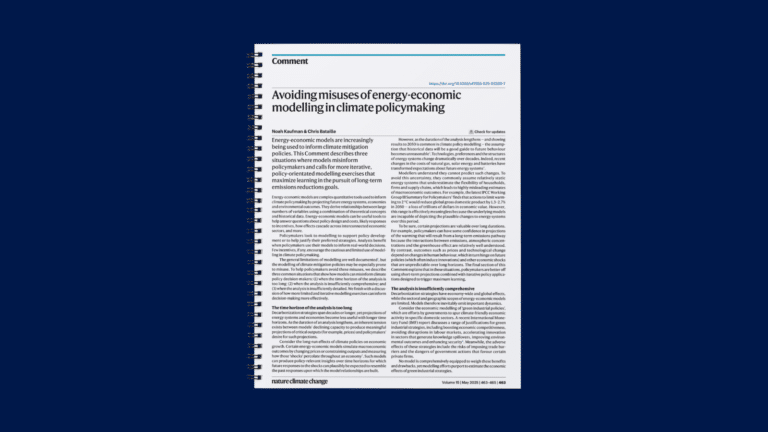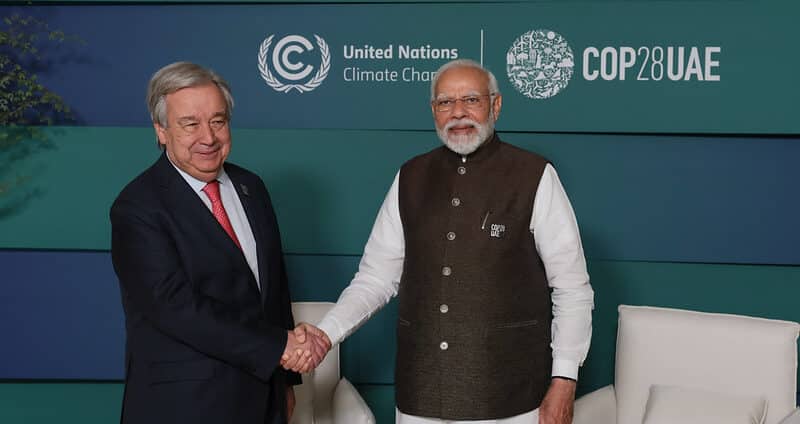This website uses cookies as well as similar tools and technologies to understand visitors’ experiences. By continuing to use this website, you consent to Columbia University’s usage of cookies and similar technologies, in accordance with the Columbia University Website Cookie Notice.
Energy Explained
Insights from the Center on Global Energy Policy
This Energy Explained post represents the research and views of the author. It does not necessarily represent the views of the Center on Global Energy Policy. The piece may be subject to further revision. Contributions to SIPA for the benefit of CGEP are general use gifts, which gives the Center discretion in how it allocates these funds. Rare cases of sponsored projects are clearly indicated.
For a full list of financial supporters of the Center on Global Energy Policy at Columbia University SIPA, please visit our website at Our Partners. See below a list of members that are currently in CGEP’s Visionary Circle. This list is updated periodically.
With the world’s largest population[1] and an economy that is expected to be worth $7 trillion by 2030,[2] India’s growth potential is substantial. This will inevitably lead to increases in the country’s demand for resources and its environmental footprint. The International Energy Agency (IEA) forecasts in its latest World Energy Outlook that India’s energy consumption[3] will increase by 30 percent by 2030 and 90 percent by 2050, with carbon emissions from energy use rising by 32 percent and 72 percent in the same period. In response, India has announced and worked toward achieving ambitious climate targets, positioning itself as an emerging market that champions environmental protection. Realizing these ambitious targets will also be key to the world achieving a 1.5°C pathway, considering that India is the world’s third-largest emitter[4] of greenhouse gasses, accounting for 7 percent of the global total annually.
This article unpacks India’s various climate commitments since 2015’s 21st Conference of the Parties to the United Nations Climate Change Conference (COP21) in Paris. In particular, the authors assess the country’s progress in meeting its Nationally Determined Commitments (NDCs) beginning in 2015, as well as the path ahead.
The first climate commitment by India was articulated in its National Statement at the United Nations Sustainable Development Summit (UNSDS) in 2015,[5] where a target of 175 gigawatts (GW) of renewable energy by 2022 was declared. Since then, India has updated and redefined its climate commitments (Table 1).
India’s Climate Commitments Clarified
In 2016, as part of its commitment to COP21 and the requirement for countries to communicate actions toward meeting the Paris Agreement’s stated goals of holding “the increase in the global average temperature to well below 2°C above pre-industrial levels” and pursuing efforts “to limit the temperature increase to 1.5°C above pre-industrial levels,” India adopted three other quantitative targets[6] for the period until 2030, including:
- Reduction in emissions intensity of GDP
- Increase in non-fossil electricity generation capacity
- Creation of new carbon sinks
Alongside these quantitative targets, the 2016 NDC also encompassed other policy-orientated commitments. Notably, the target of 175 GW was not included in the list, though it is referred to in the text.
Subsequently, India’s National Statement at COP26[7] in Glasgow signaled a stepping-up of the Paris commitments, with five targets labeled Panchamrit, the five “nectars for immortality.” These targets included increasing non-fossil capacity to 500 GW, meeting half of the country’s energy requirements from renewables, reducing carbon emissions relative to an unspecified baseline, a more aggressive reduction in emissions intensity with respect to GDP relative to the Paris commitment, and a target for net zero by 2070.
The Panchamrit were redefined in India’s updated NDC in 2022.[8] This updated NDC, in compliance with the ratcheting mechanism in the Paris Agreement, raised the bar on two of the three quantitative targets in the 2016 NDC. Notably, it still does not include a target for non-fossil electricity capacity or the net zero commitment that were part of the Panchamrit, though the latter is referred to elsewhere in the document. There was a continued emphasis on policy commitments, including a new focus on demand-side action to achieve sustainable consumption in the form of Mission LiFE.[9]
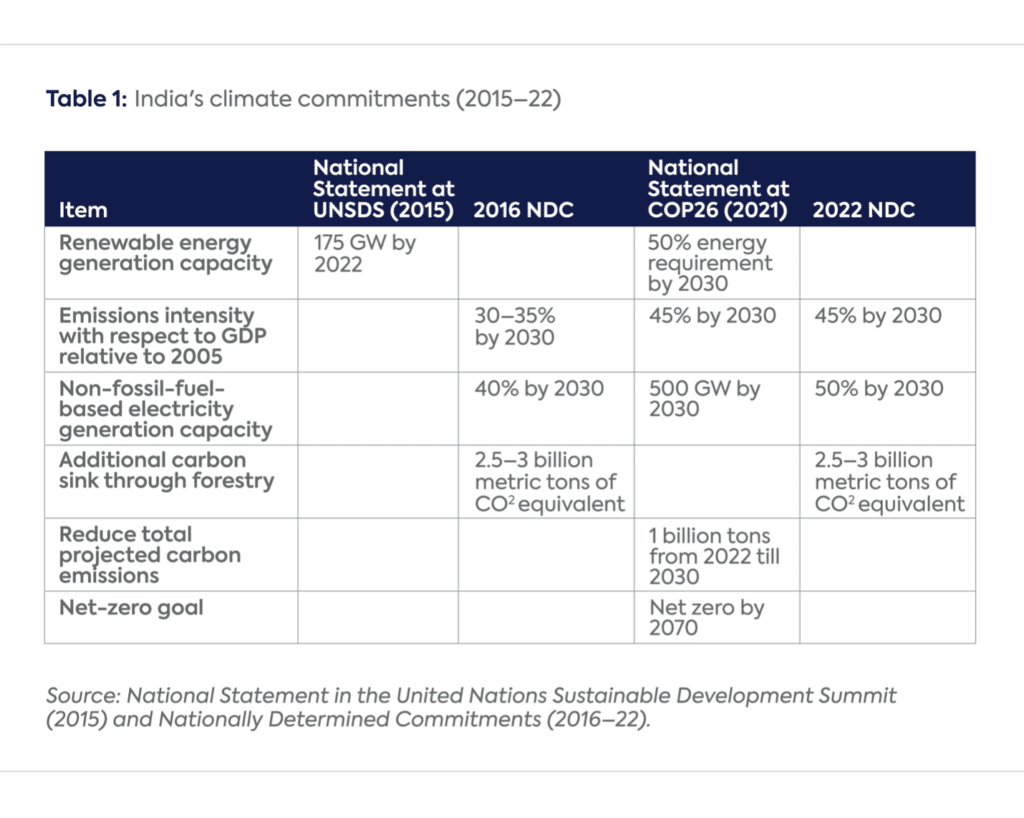
Target 1: Reduce Emissions Intensity of GDP
The first quantitative commitment in the 2016 NDC is to reduce the carbon emissions intensity with respect to GDP by 33–35 percent by 2030, relative to 2005 levels. The 2022 NDC increased this target to 45 percent by 2030. Notably, this is one commitment that remained consistent between the national statement at COP26 and the 2022 NDC. In its 2021 Biennial Update to the UNFCCC, India reported that it had already achieved a 24 percent reduction in emissions intensity, excluding agriculture, between 2005 and 2016.
The Statistical Review of World Energy reported that carbon dioxide emissions from energy combustion in India grew by 3.6 percent over 2012–22.[10] According to the International Monetary Fund, the country’s GDP at current prices[11] grew by 6.8 percent during the same period and is forecast to accelerate to nearly 9 percent between 2022 and 2028. Using these two data series, the authors estimate that India could meet its emissions intensity reduction target within the next two years, well before the 2030 target date (Figure 1). While energy use constitutes 75 percent of total greenhouse gas emissions, and other sectors such as agriculture, industrial processes, and waste will also have to be accounted for, it does appear that the emissions intensity target that India committed to could have been more ambitious.
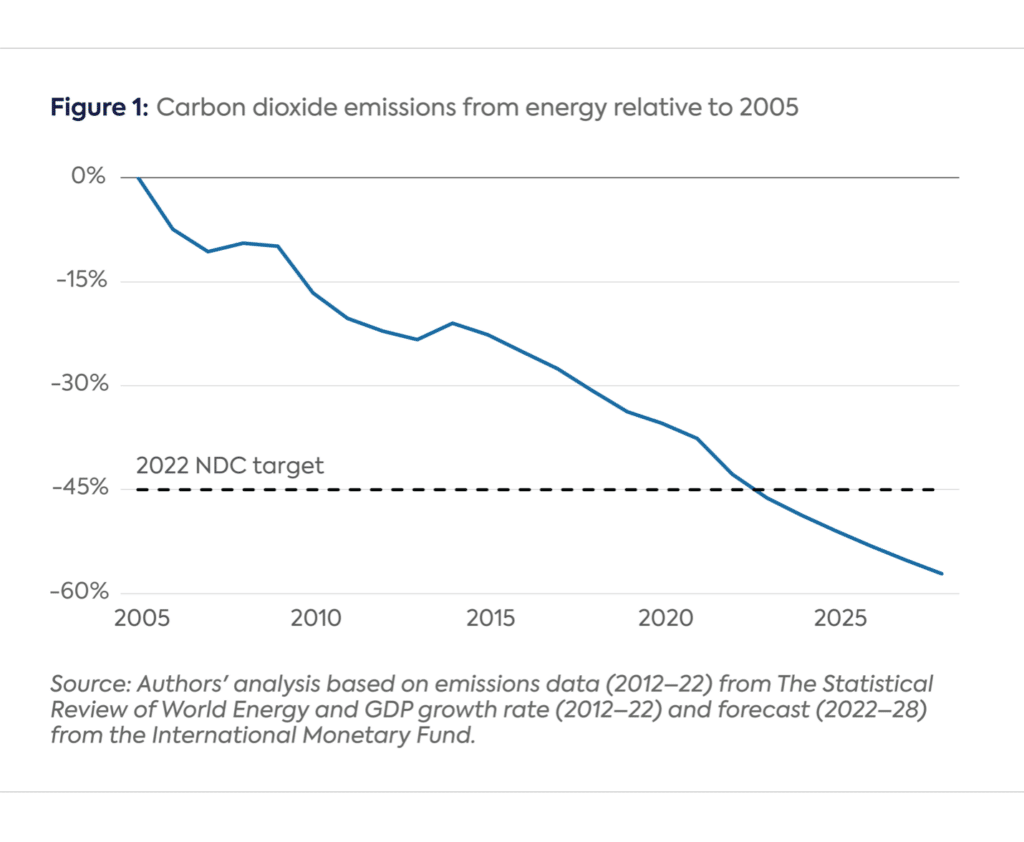
Target 2: Increase Non-Fossil Electricity Generation Capacity
In September 2015, when Prime Minister Narendra Modi initially announced a target of 175 GW of renewable energy capacity, India had 78 GW[12] of renewable electricity capacity. Since then, considerable progress has been achieved, and the country has an installed capacity of 174 GW as of June 2023.[13] This marks the third-largest increase globally during this period, following China and the United States.[14] Including nuclear, the total carbon-free generation capacity is nearly 180 GW. In other words, the country has added nearly 12 GW of non-fossil capacity per year since 2015. This already accounts for 43 percent of the total installed capacity in the country, surpassing the 2016 NDC commitment of 40 percent by 2030. Despite this progress, fossil fuels still account for nearly 73 percent of the total electricity generation,[15] though down from 82 percent in 2015.[16]
The National Statement at COP26 raised this target to 500 GW by 2030. This would require the country to add over 3.5 GW every month, or 43.5 GW every year, between now and December 2030. This is more than what all of Europe and North America has averaged since 2015, and only China has added non-fossil capacity at a faster rate. To meet this challenge, the government has decided to invite bids[17] for 50 GW of renewable energy capacity annually between financial year 2023–24 and 2027–28.
Although the updated NDC does not specify a generation capacity target in terms of gigawatts, it does mandate that 50 percent of the total generation capacity should come from non-fossil sources. According to estimates from the Central Electricity Authority of the Ministry of Power, by 2030, 64–65 percent[18] of installed capacity will be non-fossil sources. Achieving this would require an annual increase of over 15 percent in non-fossil capacity during this period. More recently, the government has increased its target for fossil fuel electricity capacity by approximately 35 GW,[19] given the lack of progress in building adequate storage capacity. Even then, renewables and nuclear combined will still account for over 60 percent of total capacity by 2030.
Target 3: Create an Additional Sink through Forest and Tree Cover
The commitment to create an additional carbon sink of 2.5 billion to 3 billion metric tons of CO2 equivalent through forest and tree cover has remained unchanged in both NDCs.
The Biennial India State of Forest Report 2017 estimated the carbon stock in Indian forests[20] to be 7,044 million metric tons (Mt) in 2015, increasing to 7,082 Mt in 2017. The 2021 update projected a further increase to 7,204 Mt,[21] indicating an increase in the carbon stock in India forests by 160 Mt between 2015 and 2021. This target seems more challenging to achieve, and India will have to make significant additional efforts here.
Other Announcements
In other commitments that are not formally in the NDCs, India declared its intention to reduce its projected carbon emissions by 1 billion metric tons between 2022 and 2030[22] at COP26. The National Statement provided no additional context or baseline, but it is presumed that this commitment aims to decrease cumulative emissions between 2022 and 2030, relative to a business-as-usual baseline. This suggests an annual reduction in baseline emissions by 125 Mt per year until 2030, or 5 percent lower than the annual emissions in 2022. With this reduction, the emissions intensity of GDP would decline at an even faster rate, 2 percent lower than the current baseline.
Another goal announced at COP26 is achieving net zero emissions by 2070. Noteworthy, though, is that among the top 20 greenhouse gas emitters globally, India’s net-zero target is at least a decade behind any other country’s announced goal. Despite this, it stands as one of India’s long-term climate goals, requiring the development of a roadmap to guide this transition. The annual Union Budget in February 2023 underscores India’s commitment to achieving net zero by 2070[23] by allocating $4.2 billion[24] for energy transition and net-zero objectives.
Conclusion
India’s NDC journey from 2016 to 2022 has seen notable successes, with some goals exceeding expectations while others still lag. With a growing population and increasing prosperity, India’s 2070 net-zero goal is ambitious for an emerging market. Crucially, if successful in meeting its climate commitments over the next seven years, India could offer a developmental model wherein a country continues to grow and prosper without significantly increasing its energy or carbon footprint. However, achieving this requires substantial additional investments and efforts.
CGEP’s Visionary Circle
Corporate Partnerships
Occidental Petroleum Corporation
Tellurian Inc
Foundations and Individual Donors
Anonymous
Anonymous
the bedari collective
Jay Bernstein
Breakthrough Energy LLC
Children’s Investment Fund Foundation (CIFF)
Arjun Murti
Ray Rothrock
Kimberly and Scott Sheffield
Notes
[1] United Nations Department of Economic and Social Affairs, “UN DESA Policy Brief No. 153: India Overtakes China as the World’s Most Populous Country,” April 24, 2023, https://www.un.org/development/desa/dpad/publication/un-desa-policy-brief-no-153-india-overtakes-china-as-the-worlds-most-populous-country/.
[2] CNBCTV18, “JPMorgan Forecasts Structural Shifts in Indian Economy, Remains Bullish on China,” October 17, 2023,¨https://www.cnbctv18.com/market/jpmorgan-forecasts-structural-shifts-in-indian-economy-remains-bullish-on-china-18071051.htm.
[3] IEA “World Energy Outlook 2023,” World Energy Outlook 2023, https://iea.blob.core.windows.net/assets/42b23c45-78bc-4482-b0f9-eb826ae2da3d/WorldEnergyOutlook2023.pdf.
[4] Energy Institute, “Resources and Data Downloads,” https://www.energyinst.org/statistical-review/resources-and-data-downloads.
[5] LiveMint, “Full Text of Narendra Modi’s Speech at UNGA Summit,” September 26, 2015, https://www.livemint.com/Politics/XQNnmExc5ruApWC3oCDrXK/Full-text-of-Narendra-Modis-speech-at-UNGA-summit.html.
[6] United Nations Framework Convention on Climate Change (UNFCCC), “India’s Intended Nationally Determined Contributions (INDC) to UNFCCC,” June 2022, https://unfccc.int/sites/default/files/NDC/2022-06/INDIA%20INDC%20TO%20UNFCCC.pdf.
[7] Prime Minister’s Office, Government of India, “National Statement by PM at COP26 Summit in Glasgow,” November 1, 2021, https://www.pmindia.gov.in/en/news_updates/national-statement-by-pm-at-cop26-summit-in-glasgow/?comment=disable&tag_term=pmspeech.
[8] United Nations Framework Convention on Climate Change (UNFCCC), “India Updated First Nationally Determined Contribution (NDC),” August 2022, https://unfccc.int/sites/default/files/NDC/2022-08/India%20Updated%20First%20Nationally%20Determined%20Contrib.pdf.
[9] Ministry of Environment, Forest and Climate Change, Government of India, “Mission Life – Mission Mode Project for Improvement of Green Cover and Wildlife Habitat,” https://missionlife-moefcc.nic.in/.
[10] Energy Institute, “Statistical Review,” https://www.energyinst.org/statistical-review.
[11] International Monetary Fund (IMF), “Gross Domestic Product, Current Prices, National Currency (NGDPD) – World Economic Outlook (WEO) Data Mapper,” https://www.imf.org/external/datamapper/NGDPD@WEO/IND.
[12] Central Electricity Authority (CEA), Government of India, “Executive Summary of the Report on ‘Optimal Generation Capacity Mix for 2029-30,’” May 2020, https://cea.nic.in/wp-content/uploads/2020/05/exe_summary-09-9.pdf.
[13] Ministry of Power, Government of India, “Power Sector at a Glance – All India,” Updated on June 12, 2023, https://powermin.gov.in/en/content/power-sector-glance-all-India.
[14] Calculated using IRENASTAT. https://pxweb.irena.org/pxweb/en/IRENASTAT/IRENASTAT__Power%20Capacity%20and%20Generation/RECAP_2023_cycle2.px.
[15] Central Electricity Authority (CEA), Government of India, “Executive Summary – Report on Optimal Generation Capacity Mix for 2032-33,” September 2023, https://cea.nic.in/wp-content/uploads/executive/2023/09/R1_Executive_Summary_September_2023.pdf.
[16] Energy Institute, “Resources and Data Downloads,” https://www.energyinst.org/statistical-review/resources-and-data-downloads.
[17] Press Information Bureau (PIB), Government of India, “Press Release: Cabinet Approves Continuation of Pradhan Mantri Gram Sadak Yojana Phase III,” https://www.pib.gov.in/Pressreleaseshare.aspx?PRID=1913789.
[18] Central Electricity Authority (CEA), Government of India, “Optimal Mix Report 2029-30 Version 2.0,” May 2023, https://cea.nic.in/wp-content/uploads/notification/2023/05/Optimal_mix_report__2029_30_Version_2.0__For_Uploading.pdf.
[19] Press Information Bureau (PIB), Government of India, “Press Release: Cabinet Approves Atmanirbhar Bharat Rojgar Yojana Extension,” November 22, 2023, https://pib.gov.in/PressReleasePage.aspx?PRID=1978680.
[20] Forest Survey of India, “India State of Forest Report 2017: Carbon Stock in India Forests,” https://fsi.nic.in/isfr2017/isfr-carbon-stock-in-india-forest-2017.pdf.
[21] Forest Survey of India, “India State of Forest Report 2021: Chapter 9,” https://fsi.nic.in/isfr-2021/chapter-9.pdf.
[22] Ministry of External Affairs, Government of India, “National Statement by Prime Minister Shri Narendra Modi at COP26 Summit in Glasgow,” https://www.mea.gov.in/Speeches-Statements.htm?dtl/34466/National+Statement+by+Prime+Minister+Shri+Narendra+Modi+at+COP26+Summit+in+Glasgow.
[23] Press Information Bureau (PIB), Government of India, “India Geared for Energy Transition and Climate Action,” February 25, 2022, https://static.pib.gov.in/WriteReadData/specificdocs/documents/2022/feb/doc202222519401.pdf.
[24] Government of India, “Speech of Nirmala Sitharaman Minister of Finance,” February 1, 2023, https://www.indiabudget.gov.in/doc/budget_speech.pdf.
More on Energy Explained Energy Explained
Assessing the Energy Impacts of the One Big Beautiful Bill Act
This special CGEP blog series, featuring six contributions from CGEP scholars, analyzes the potential impacts of the OBBBA across a range of sectors.

Q&A: An Energy Take on the Current State of the Iran-Israel-US Conflict
The conflict between Iran, Israel, and now the United States has yet to disrupt energy supplies to global markets.

Trump’s Seismic, Irrevocable Middle East AI Shift
The commercial deals Trump struck on artificial intelligence cooperation will likely shift the global balance of power for one of this century's most critical technologies.

Q&A: Why Trump’s Gulf Tour Matters for Energy, AI, and Geopolitics
President Donald Trump's first official foreign policy trip, as in his first term, was to Saudi Arabia earlier this month, with additional stops in Qatar and the United Arab Emirates.

Relevant
Publications
The United States Needs a Nuclear Operation Warp Speed
A nuclear energy resurgence is vital to meet rising electricity demand.
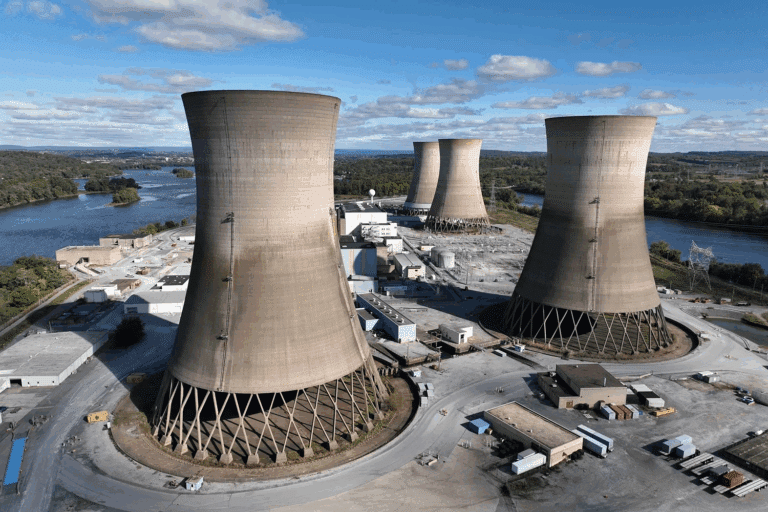
Columbia India Energy Dialogue: Event Summary

Avoiding Misuses of Energy-Economic Modeling in Climate Policymaking
Energy-economic models are increasingly being used to inform climate mitigation policies. This Comment describes three situations where models misinform policymakers and calls for more iterative, policy-orientated modelling exercises that maximize learning in the pursuit of long-term emissions reductions goals.
